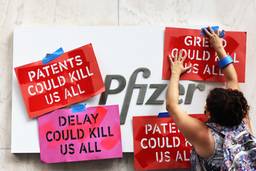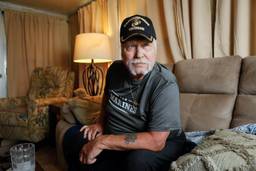Joe Biden Shouldn't Shy Away From the Radicalism of the New Deal
‘Why the New Deal Matters’ author Eric Rauchway explains why embracing FDR’s signature programs is not just a moral imperative—it’s good politics.
Natasha Hakimi Zapata

President Joe Biden struck an urgent note during his address to Congress on April 28. “We have to prove democracy still works,” he said. “That our government still works — and can deliver for the people.”
To those familiar with the history of the New Deal, the echoes are clear. As was the case in 1933, the United States finds itself at a crossroads. The Covid-19 pandemic has killed nearly 600,000 Americans and widened what was already a chasm separating the country’s rich from its poor. Meanwhile, the far right has entrenched itself in our politics, even with former President Donald Trump’s defeat in the 2020 election. Like Franklin Delano Roosevelt before him, Biden is betting on an ambitious set of programs and reforms to restore faith in the American project before it’s too late.
As historian Eric Rauchway argues in his new book, Why the New Deal Matters, embracing FDR’s signature programs is not just a moral imperative — it’s good politics. The Civilian Conservation Corps, a version of which Sen. Ed Markey (D-Mass.) and Rep. Alexandria Ocasio-Cortez (D-N.Y.) include in their Green New Deal proposal, offers a model to create well-paying jobs while addressing the existential threat of climate change. By the same token, the Tennessee Valley Authority — which built the Wilson Dam and transformed the economy of seven impoverished states — can serve as a blueprint to repair the country’s crumbling infrastructure.
These measures would not only help address a pressing crisis, but — if recent polling of Biden’s American Jobs Plan is any indication — would be enormously popular with the American public.
Over the phone, Rauchway spoke with In These Times about the lessons of the New Deal and how it can be revised for modern-day America. He also explored the ways the New Deal reinforced and perpetuated the racism and misogyny of 1930s America.
This transcript has been edited for length and clarity.
Natasha Hakimi Zapata: What did President Franklin Delano Roosevelt hope to achieve with the New Deal?
Eric Rauchway: The key thing to understand about the New Deal is that it was a response to a crisis of democracy. The Great Depression had broken the economy, and many representative governments both in the United States and elsewhere were not particularly responsive. With far-right movements on the rise around the world, people looked at Benito Mussolini and said, “Well, that fella has the right idea.”
Adolf Hitler came to power in January 1933, right between Franklin D. Roosevelt’s election and his first inauguration. One of Roosevelt’s friends told him during that period, “If you succeed, you will be remembered as one of the best presidents of the United States; and if you fail, you will be remembered as one of the worst.” To which Roosevelt replied: “If I fail, I will be the last.” He really did think that democracy was in dire straits, and with good reason. There were mass protests throughout the United States that were ideologically inchoate, and they could have very easily tilted toward the far right.
Roosevelt feared those discontented with the government’s inaction could follow a leader like Huey Long, who was charismatic but unscrupulous and not particularly respectful of the rule of law, or perhaps a business-backed authoritarian like Douglas MacArthur, who would be installed to put down mass movements in the name of opposing Communism. In his acceptance speech for the Democratic nomination in 1932, Roosevelt argued the only way to defuse far-right threats was to offer a positive program of reconstruction. And that’s what the New Deal was — a program to restore people’s belief that democracy could work for them and broaden conceptions of social justice.
NHZ: As inequality has accelerated and American democracy faces new threats from the Right, what would you like our legislators to learn from the New Deal?
ER: I would like our legislators to see the New Deal as essential support for democracy and the programs themselves as essentially humane. Roosevelt talked about the idea that people don’t just need something to live on; they need something to live for. That was the purpose of the New Deal.
Some have called its programs “socialist,” but Roosevelt didn’t see them that way and neither did Norman Thomas, a Socialist Party leader in the 1930s. What mattered was that they gave people a sense of dignity and decency; they made people feel they were participating in a society that was worth living in. If today’s policy proposals have a sustainable set of goals and offer people a chance to lead decent lives, then they’re worth supporting.
NHZ: Jamelle Bouie wrote about Why the New Deal Matters in the New York Times recently, concluding that the New Deal can be seen as a third founding moment in the history of American democracy. Why do you think, as Bouie writes, that the United States still hasn’t lived up to the New Deal’s promise of economic equality and opportunity?
ER: To put things bluntly, because it threatened people who have lots of money or power. The New Deal came about at a time when everything seemed to be in crisis, so lots of people were willing to support dramatic changes in the existing political and economic system. No sooner had it been successful than folks in boardrooms and in banks began to worry that it might be too successful.
Even within the first 100 days of his presidency, Roosevelt had already begun to run up against resistance to some of the things he wanted to do. But he and the New Dealers in the Democratic Party, along with some liberal Republicans, managed to seize that moment and put through a number of policies that were effective and popular.
Not only did the economy recover, but a lot of people shared in that recovery, which made the Democratic Party become more popular. Democrats gained seats in the 1934 elections, and then Roosevelt won in a record landslide in 1936. One of the groups that Roosevelt’s first term won over to the Democratic Party was Black voters, which has remained a staple of the Democratic coalition since.
NHZ: In your book, you write that “New Deal programs sometimes left existing segregation untouched and even expanded it into new areas, perpetuating it for new generations.” Would you agree with House Majority Whip James Clyburn’s recent remarks that “FDR’s legacy was not good for Black people”?
ER: I am going to side with the vast majority of Black voters who clearly believed FDR’s legacy was good for Black people. They seem to be a better judge of their own interests than James Clyburn.
The Roosevelt administration represented a Democratic Party that was divided in the 1930s between its white, Southern, segregationist wing and its Northern, multiracial and more labor-based wing. The New Deal marked the Democratic Party’s shift toward the latter, although it didn’t happen overnight. When New Deal programs were administered by the local Democratic Party in the South, they tended to perpetuate segregation, perhaps unsurprisingly.
A good example here is the Tennessee Valley Authority (TVA) in the Tennessee River Valley, which is the birthplace of the original Ku Klux Klan. You can derive what the racial politics of the region were from that observation alone. But while the TVA had segregated works, it also had Black workers and even Black managers. They expressed their frustrations within the TVA rather than attack it because they knew it was providing well-paying jobs under good conditions.
What Clyburn’s remarks leave out is that when the New Deal was administered at the national level — for example, by Harry Hopkins at the Works Progress Administration (WPA) or Harold Ickes at the Public Works Administration (PWA) — both were committed to civil rights. Discrimination was not only against policy, but it eventually became illegal in public works.
As the National Urban League said at the time, the WPA offered the first meaningful white-collar opportunities to Black Americans. In many ways, it allowed them to move out of the South and into the urban parts of the North and the West.
NHZ: President Joe Biden has invited comparisons to FDR, and CNN has even referred to him by his initials, JRB. Would you say Biden and his administration have internalized the lessons of the New Deal?
ER: Biden has been involved in Democratic politics through a time generally referred to as the neoliberal period, when the Democratic Party has been highly skeptical of the New Deal. This period really lasted until, I don’t know, last week? It wasn’t an overnight shift. People like Bernie Sanders and Alexandria Ocasio-Cortez on the Left have been calling for Democrats to revive and improve on the New Deal, both as a source of inspiration and as a concrete set of programs.
I think the Biden administration could have gone even farther than it did on the recent stimulus package. The package is far bigger than the one the Democrats passed in 2008 – 2009 and far more focused on Main Street than Wall Street, but it doesn’t get close to the New Deal. Describing payments as a “stimulus” implies there’s nothing fundamentally unhealthy about the U.S. economy, that it just needs a solid jolt of caffeine to start moving again. The focus of the New Deal wasn’t a Keynesian-style stimulus; it was aimed at rebalancing the scales in the American economy and in American society more generally.
[The American Jobs Plan] that is now before Congress is much closer in spirit to the New Deal, especially with its broad conception of what infrastructure entails. If we have a program where we spend a lot of money to build solar panel arrays, wind farms, pumping facilities for endangered shorelines and things like that, we’re talking about concrete achievements that can empower people.
NHZ: Do you think the American Jobs Plan could be Biden’s FDR moment?
ER: If the American Jobs Plan goes through, and it’s implemented in a way that is visibly effective, then I would be surprised if the Biden administration and the Democratic Party didn’t reap the benefits electorally. One of the great lessons of the New Deal is that good policy is good politics. It may seem like an obvious thing to say, but if the administration is effective and it helps people in ways they appreciate, then they tend to support the administration and its programming. It should be intuitive, but it’s not.
In the age of austerity, politicians have told themselves, “Let’s make our voters suffer, and then they will appreciate how competent and serious we are.” The Roosevelt administration took the opposite view. As Harry Hopkins put it at the time, “We will spend and spend, tax and tax, and elect and elect.” These types of programs, if they work and people appreciate that they work, tend to lead to lasting majorities.
NHZ: Rep. Alexandria Ocasio-Cortez (D-N.Y.) and Sen. Ed Markey (D-Mass.) recently reintroduced the Green New Deal in a series of public events. In what ways are its proposals similar to the original New Deal?
ER: We need to meet an ecological crisis now just as we did in 1933. Intensive farming had used up a lot of the land in ways that had destroyed its utility, leading in part to the Dust Bowl. A large part of the New Deal was devoted to making agriculture sustainable through hydroelectric power, which we would now call green energy, but also through soil conservation. The United States adopted physical and chemical methods of farming that would allow the prairie to yield good crops and sustainable grazing areas for decades to come.
As I point out in the book, the New Deal is one of the largest — if not the only — successful articulation of American patriotism that doesn’t involve going to war and killing people. That’s a resource that folks can draw on to try to mobilize people and give us pride in our ability to do constructive rather than destructive things. Rep. Ocasio-Cortez has also said she would like the Green New Deal to rectify some of the shortcomings of the original New Deal and specifically address structural inequalities created by infrastructure projects of the past with an emphasis on racial justice.
NHZ: Ocasio-Cortez and Markey recently introduced the Civilian Climate Corps for Jobs and Justice Act of 2021. How did FDR’s Civilian Conservation Corps (CCC) work and what kind of potential would a new version hold?
ER: The original CCC was not only focused on conservation but on employing young men, precisely because they were understood to be the most susceptible to dangerous anti-social movements and behaviors. It was run by the War Department and was aimed at giving folks who might otherwise have been drawn to paramilitary movements a democratic, pacific thing to do instead.
The CCC was not very big during the New Deal compared to the WPA, but it was immensely popular in large measure because of the kinds of work it did. It focused specifically on conservation projects that included reforestation and reclamation, irrigation and flood control. It did a tremendous amount of work in both state and national parks. The idea of getting the country’s youth into the wilderness and doing things for the common good has struck a chord with people since the Great Depression, so I’m not surprised they want to revive it, although I doubt it would be implemented in the same way.
NHZ: One modern twist, it seems, is that at least 50% of the new CCC projects would be going to BIPOC communities that have been historically oppressed.
ER: I’d say that idea is lifted directly from the original New Deal. One of the things I tried to do with this book is integrate Native discussions about what was then called the “Indian New Deal.” The Indian Emergency Conservation Work program was specifically thought of as an “Indian CCC,” and it was quite large and effective in bringing material benefits to these nations in many cases. Perhaps the Roosevelt administration didn’t achieve its greatest successes with the Indian New Deal, but it did reverse a policy of breaking up native lands and giving them away to individuals. It also restored the federal government’s commitment to Indian sovereignty.
NHZ: Speaking of people who were largely left out of the New Deal, what kind of impact did its programs have on American women?
ER: From the beginning, the Roosevelt administration contained a particular strain of feminist politics, and not only because of Eleanor Roosevelt’s influence in the Roosevelt household. Frances Perkins, Roosevelt’s secretary of labor, also became an integral figure in the implementation of social welfare policies. But those social welfare policies generally focused on preserving the normative idea of the family, with the male breadwinner at its head. They thought their top priority was giving men jobs, and that it would lead to assistance for their wives and children.
Women were eligible for specific employment under New Deal programs that included leading in-kind assistance and library programs, among other stereotypically feminine jobs. There were women professionals and artists who were employed by divisions of the WPA, but most of this work was in construction, which was limited to men at the time. The New Deal reinforced and preserved the gender norms of the time, by and large.
NHZ: FDR supported collective bargaining, and the National Labor Relations Act is one of his lasting legacies. Do you think legislation like the PRO Act, which strengthens collective bargaining rights, is necessary to implement an effective modern-day New Deal?
ER: During the ultimately failed effort to organize an Amazon warehouse in Bessemer, Ala., President Biden gave a statement about how it’s up to the workers to decide whether they want to join a union — that it’s not up to him, and it’s not up to management. That is no more than a statement of the law that we now have in this country today, but it was greeted as a revolutionary Joe Hill kind of thing — because merely affirming that we have union rights in law now seems radical for a president of the United States. It suggests to me where we are as a society.
New Deal legacy laws are actually pretty good already. The problem is that we don’t staff or adequately fund the agencies that are supposed to enforce them. We’ve also allowed the federal judiciary to strip away many of the rights that the letter of the law guarantees.
To reinvigorate the union movement probably would be a tremendous boon for any New Deal type program going forward, and the Democratic Party more generally.
NATASHA HAKIMI ZAPATA is an award-winning journalist and university lecturer based in London. Her work has appeared in The Nation, Los Angeles Review of Books, ScheerPost, Truthdig, Los Angeles Magazine and elsewhere. She has received several Southern California Journalism and National Arts & Entertainment Journalism awards, among other honors.







